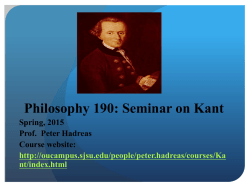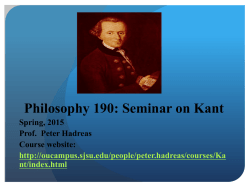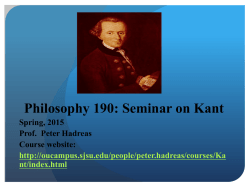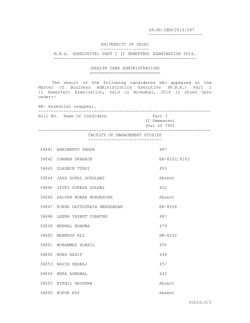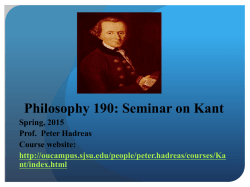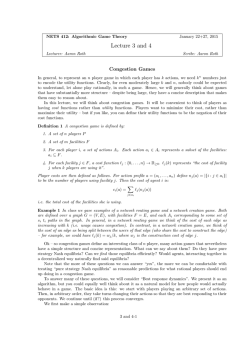
(1787), pp. 106-124
Philosophy 190: Seminar on Kant Spring, 2015 Prof. Peter Hadreas Course website: http://oucampus.sjsu.edu/people/peter.hadreas/courses/Ka nt/index.html NOTE: The Guyer and Wood translation of the Critique of Pure Reason – the text we’re using -- can be accessed online at http://strangebeautiful.com/lmu/readings/ka nt-first-critique-cambridge.pdf The Dedication (CPR: p. 91) Bacon of Verulam1 (Francis Bacon) The Great Instauration. Preface ”Of our own person we will say nothing. But as to the subject matter with which we are concerned, we ask that men think of it not as an opinion but as a work; and consider it erected not for any sect of ours, or for our good pleasure, but as the foundation of human utility and dignity. Each individual equally, then, may reflect on it himself...for his own part...in the common interest. Further, each may well hope from our instauration [an act of repairing]2 that it claims nothing infinite, and nothing beyond what is mortal; for in truth it prescribes only the end of infinite errors, and this is a legitimate end.” 1. Francis Bacon was the 1st Baron of Verulam (1561–1626) 2. Text in brackets was added by the instructor. (GENERAL) QUESTION Francis Bacon How does Kant quoting Francis Bacon’s statement in the Great Instauration fit with Kant’s goals in The Critique of Pure Reason? Bacon writes: “Further, each may well hope from our instauration [an act of repairing] that it claims nothing infinite, and nothing beyond what is mortal; for in truth it prescribes only the end of infinite errors, and this is a legitimate end.” First Preface to First Edition of the Critique of Pure Reason (1781), pp. 99-105. First Preface to First Edition of Critique of Pure Reason (1781), pp. 99-105. I. The Deplorable State of Metaphysics “Human reason has the peculiar fate in one species of its cognitions that it is burdened with questions which it cannot dismiss, since they are given to it as problem by the nature of reason itself, but which it also cannot answer, since they transcend every capacity of human reason.” (p. 99) Preface to First Edition of Critique of Pure Reason (1781), pp. 99-105. I. The Deplorable State of Metaphysics “Reason falls into this perplexity through no fault of its own. It begins from principles whose use is unavoidable in the course of experience and at the same time sufficiently warranted by it. With these principles it rises (as its nature also requires) ever higher, to more remote conditions. But since it becomes aware in this way that its business must always remain incomplete because the questions never cease, reason sees itself necessitated to take refuge in principles that overstep all possible use in experience, and yet seem so unsuspicious that even ordinary common sense agrees with them..” (p. 99) Preface to First Edition of Critique of Pure Reason (1781), pp. 99-105. I. The Deplorable State of Metaphysics “But it thereby falls into obscurity and contradictions, from which it can indeed surmise that it must somewhere be proceeding on the ground of hidden errors; but it cannot discover them, for the principles on which it is proceeding, since they surpass the bounds of all experience, no longer recognize any touchstone of experience. The battlefield of these endless controversies is called metaphysics1.” (p. 99) 1. Henceforward yellow coloration will be used in powerpoints when Guyer and Wood employ boldface. Preface to First Edition of Critique of Pure Reason (1781), pp. 99-105. I. The Deplorable State of Metaphysics “Once in recent times it even seemed as though an end would be put to all these controversies, and the lawfulness of all the competing claims would be completed decided, through a certain physiology of human understanding (by the famous Locke) . . nevertheless she [metaphysics] still asserted her claims because in fact this genealogy was attributed to her falsely; thus metaphysics fell back into the same old worm-eaten dogmatism, and thus into the same position of contempt out of which the science was to have been extricated. Now after all paths (as we persuade ourselves) have been tried in vain, what rules is tedium and complete indifferentism, the mother of chaos and night in the sciences, . . . (p. 100) Preface to First Edition of Critique of Pure Reason (1781), pp. 99-105. I. The Deplorable State of Metaphysics “For it is pointless to affect indifference with respect to such inquiries, to whose object human nature cannot be indifferent. Moreover, however much they may think to make themselves unrecognizable by exchanging the language of the schools for a popular style, these so-called indifferentists, to the extent that they think anything at all, always unavoidably fall back into metaphysical assertions, which they yet professed so much to despise.” (p. 100) Apt Comparison to Heidegger human involvement as ‘pre-ontological’? As quoted in the previous slide, Kant has states: “. . . to the extent that they [the indifferentists] think anything at all, always unavoidably fall back into metaphysical assertions, which they yet professed so much to despise.” (p. 100) How does this initial claim regarding metaphysicalpresuppositions compare with Heidegger’s in Being and Time: “So if we should reserve the term ‘ontology’ for that theoretical inquiry which is explicitly devoted to the meaning of entities, then, what we have in mind in speaking of Dasein’s ‘being ontological’ is to be designated as something ‘pre-ontological.’ It does not signify simply ‘being-ontical,’ however, but rather ‘being in such a way that one has an understanding of being.’” (Macquarrie & Robison, English trans. p. 32)[Original German: p. 12] Preface to First Edition of the Critique of Pure Reason (1781), pp. 99-105. II. The Constructive and Deceptive Nature of Reason “Yet by this [a critique of pure reason] I do not understand a critique of books and systems, but a critique of the faculty of reason in general, in respect of all the cognitions after which reason might strive independently of all experience, and hence the decision about the possibility or impossibility of a metaphysics in general, and the determination of its sources, as well as its extent and boundaries, all, however, from principles.” (p. 101) Preface to First Edition of Critique of Pure Reason (1781), pp. 99-105. II. The Constructive and Deceptive Nature of Reason “In this business I have made comprehensiveness my chief aim in view, and I make bold to say that there cannot be a single metaphysical problem that has not been solved here, or at least to the solution of which the key has not been provided. In fact pure reason is such a perfect unity that if its principle’ were insufficient for even a single one of the questions that are set for it by its own nature, then this [principle] might as well be discarded, because then it also would not be up to answering any of the other questions with complete reliability. (p. 101-2) Preface to First Edition of Critique of Pure Reason (1781), pp. 99-105. II. The Constructive and Deceptive Nature of Reason “While I am saying this I believe I perceive in the face of the reader an indignation mixed with contempt at claims that are apparently so pretentious and immodest; and yet they are incomparably more moderate than those of any author of the commonest program who pretends to prove the simple nature of the soul or the necessity of a first beginning of the world. For such an author pledges himself to extend human cognition beyond all bounds of possible experience, of which I humbly admit that this wholly surpasses my capacity;” Preface to First Edition of Critique of Pure Reason (1781), pp. 99-105. III. How Certainty and Clarity are achieved in The Critique of Pure Reason Regarding certainty: “I am acquainted with no investigations more important for getting to the bottom of that faculty we call the understanding, and at the same time for the determination of the rules and boundaries of its use, than those I have undertaken in the second chapter of the Transcendental Analytic, under the title Deduction of the Pure Concepts of the Understanding; they are also the investigations that have cost me the most, but I hope not unrewarded, effort. This inquiry, which goes rather deep, has two sides. (p. 103) The meaning of transcendental and transcendent : “I call all cognition transcendental that is occupied not so much with objects but rather with our mode of cognition of objects insofar as this is to be possible a priori. A system of such concepts would be called transcendental philosophy.” CPR, p. 149) As the CPR editors state on p. 717, we find in R 4851 (177276) 18:10: “Cognition is called transcendental with regard to its origin, transcendent with regard to the object [Objects] that cannot be encountered in any experience. Preface to First Edition of Critique of Pure Reason (1781), pp. 99-105. III. How Certainty and Clarity are achieved in the CPR Regarding certainty[continued]: “One side refers to the objects of the pure understanding, and is supposed to demonstrate and make comprehensible the objective validity of its concepts a priori; thus it belongs essentially to my ends. The other side deals with the pure understanding itself, concerning its possibility and the powers of cognition on which it itself rests; thus it considers it in a subjective relation, and although this position is of great importance in respect of my chief end, it does not belong essentially to it; because the chief question always remains: "What and how much can understanding and reason cognize free of all experience?" and not: "How is the faculty of thinking itself possible? (p. 103) Preface to First Edition of Critique of Pure Reason (1781), pp. 99-105. III. How Certainty and Clarity are achieved in the CPR Regarding clarity “Finally, as regards clarity, a the reader has a right to demand first discursive (logical) clarity, through concepts, but then also intuitive (aesthetic) clarity, through intuitions, that is, through examples or other illustrations in concreto. I have taken sufficient care for the former. That was essential to my undertaking but was also the contingent cause of the fact that I could not satisfy the second demand, which is less strict but still fair. In the progress of my labor I have been almost constantly undecided how to deal with this matter.” Kant’s Explains the Style He’s Adopted in the Critique of Pure Reason III. How Certainty and Clarity are achieved in the CPR Regarding clarity [continued] “Examples and illustrations always appeared necessary to me, and hence actually appeared in their proper place in my first draft. But then I looked at the size of my task and the many objects with which I would have to do, and I became aware that this alone, treated in a dry, merely scholastic manner, would suffice to fill an extensive work; Kant’s Explains the Style He’s Adopted in the Critique of Pure Reason III. How Certainty and Clarity are achieved in the CPR Regarding clarity [continued] [continued from previous slide] “thus I found it inadvisable to swell it further with examples and illustrations, which are necessary only for a popular aim, especially since this work could never be made suitable for popular use, and real experts in this science do not have so much need for things to be made easy for them; although this would always be agreeable, here it could also have brought with it something counter- productive. (pp. 103-4) Preface to Second Edition of the Critique of Pure Reason (1787), pp. 106-124. Preface to Second Edition of the Critique of Pure Reason (1787), pp. 106-124. “That from the earliest times logic has traveled this secure course can be seen from the fact that since the time of Aristotle it has not had to go a single step backwards, unless we count the abolition of a few dispensable subtleties or the more distinct determination of its presentation, which improvements belong more to the elegance than to the security of that science. What is further remarkable about logic is that until now it has also been unable to take a single step forward, and therefore seems to all appearance to be finished and complete.” QUESTIONS Surely logicians today would not agree with Kant’s statement: “What is further remarkable about logic is that until now it has also been unable to take a single step forward, and therefore seems to all appearance to be finished and complete.” In what way is Kant simply wrong about the logic of his day as ‘finished and complete’? In what way does the progress in the development of logic since Kant not at issue to his overall point. Preface to Second Edition of the Critique of Pure Reason (1787), pp. 106-124. “How much more difficult, naturally, must it be for reason to enter upon the secure path of a science if it does not have to do merely with itself, but has to deal with objects too; hence logic as a propadeutic constitutes only the outer courtyard, as it were, to the sciences; and when it comes to information, a logic may indeed be presupposed in judging about the latter, but its acquisition must be sought in the sciences properly and objectively so called.” Preface to Second Edition of Critique of Pure Reason (1787), pp. 106-124. Insofar as there is to be reason in these sciences, something in them must be cognized a priori, and this cognition can relate to its object in either of two ways, either merely determining the object and its concept (which must be given from elsewhere), or else also making the object actual. The former is theoretical, the latter practical cognition of reason. In both the pure part, the part in which reason determines its object wholly a priori, must be expounded all by itself, however much or little it may contain, and that part that comes from other sources must not be mixed up with it; for it is bad economy to spend blindly whatever comes in without being able later, when the economy comes to a standstill, to distinguish the part of the revenue that can cover the expenses from the part that must be cut. Preface to Second Edition of Critique of Pure Reason (1787), pp. 106-124. Mathematics and physics are the two theoretical cognitions of reason that are supposed to determine their objects a priori, the former entirely purely, the latter at least in part purely but also following the standards of sources of cognition other than reason. (p. 107) Preface to Second Edition of Critique of Pure Reason (1787), pp. 106-124. “Mathematics has, from the earliest times to which the history of human reason reaches, in that admirable people the Greeks, traveled the secure path of a science. Yet it must not be thought that it was as easy for it as for logic --in which reason has to do only with itself -– to find that royal path, or rather itself to open it up; rather, I believe that mathematics was left groping about for a long time (chiefly among the Egyptians), and that its transformation is to be ascribed to a revolution, brought about by the happy inspiration of a single man in an attempt from which the road to be taken onward could no longer be missed, and the secure course of a science was entered on and prescribed for all time and to an infinite extent.” Preface to Second Edition of Critique of Pure Reason (1787), pp. 106-124. “The history of this revolution in the way of thinking -which was far more important than the discovery of the way around the famous Cape --and of the lucky one who brought it about, has not been preserved for us. But the legend handed down to us by Diogenes Laertius -- who names the reputed inventor . . .”1 1. Kant goes on to name Thales as the first to propose mathematical proof. In a letter to Schütz (see notes p. 715) Kant says he understands the proof in Euclid’s Elements, Book I, proposition 5 to have originated with Thales. Thales’ Theorem Thalēs, c. 624 – c. 546 BC) Thales' theorem: if AC is a diameter, then the angle at B is a right angle. Thales’ Theorem Let ABC be a triangle in a circle where AB is a diameter in that circle. Then construct a new triangle ABD by mirroring triangle ABC over the line AB and then mirroring it again over the line perpendicular to AB which goes through the center of the circle. Since lines AC and BD are parallel, likewise for AD and CB, the quadrilateral ABCD is a parallelogram. Since lines AB and CD are both diameters of the circle and therefore are equal length, the parallelogram must be a rectangle. All angles in a rectangle are right angles.1 1. Downloaded from http://en.wikipedia.org/wiki/Thales%27_theorem on Feb. 1, 2015. Preface to Second Edition of the Critique of Pure Reason (1787), pp. 106-124 “It took natural science much longer to find the highway of science; for it is only about one and a half centuries since the suggestion of the ingenious Francis Bacon partly occasioned this discovery and partly further stimulated it, since one was already on its tracks -which discovery, therefore, can just as much be explained by a sudden revolution in the way of thinking. Here I will consider natural science only insofar as it is grounded on empirical principles. Preface to Second Edition of the Critique of Pure Reason (1787), pp. 106-124 [continued from previous slide] “When Galileo rolled balls of a weight chosen by himself down an inclined plane, or when Torricelli’ made the air bear a weight that he had previously thought to be equal to that of a known column of water, or when in a later time Stahl's changed metals into calyx and then changed the latter back into metal by first removing something and then putting it back again . . . Preface to Second Edition of the Critique of Pure Reason (1787), pp. 106-124 [continued from previous slide] “a light dawned on all those who study nature. They comprehended that reason has insight only into what it itself produces according to its own design; that it must take the lead with principles for its judgments according to constant laws and compel nature to answer its questions, rather than letting nature guide its movements by keeping reason, as it were, in leading-strings; for otherwise accidental observations, made according to no previously designed plan, can never connect up into a necessary law, which is yet what reason seeks and requires.” (p. 109) A Standard Contemporary Textbook on Scientific Hypotheses . . . Three additional points about [scientific] hypotheses. The first is that a hypothesis is not derived from the evidence to which it pertains but rather is added to the evidence by the investigator. . . . The second point is that a hypothesis directs the search for evidence. . . . The third point concerns the proof of hypotheses . . . Concluding that a hypothesis is proven true by the discovery that one of its implications is true amounts to the fallacy of affirming the consequent. . . .1 1. Hurley, Patrick J., A Concise Introduction to Logic, 10th edition, (Wadsworth, 2008), p. 548 Preface to Second Edition of the Critique of Pure Reason (1787), pp. 106-124 “Metaphysics -- a wholly isolated speculative cognition of reason that elevates itself entirely above all instruction from experience, and that through mere concepts (not, like mathematics, through the application of concepts to intuition), where reason thus is supposed to be its own pupil -- has up to now not been so favored by fate as to have been able to enter upon the secure course of a science, even though it is older than all other sciences, and would remain even if all the others were swallowed up by an all-consuming barbarism. For in it reason continuously gets stuck, even when it claims a priori insight (as it pretends) into those laws confirmed by the commonest experience.” (p. 109). Preface to Second Edition of the Critique of Pure Reason (1787), pp. 106-124 “I should think that the examples of mathematics and natural science, which have become what they now are through a revolution brought about all at once, were remarkable enough that we might reflect on the essential element in the change in the ways of thinking that has been so advantageous to them, and, at least as an experiment, imitate it insofar as their analogy with metaphysics, as rational cognition, might permit. Up to now it has been assumed that all our cognition must conform to the objects; but all attempts to find out something about them a priori through concepts that would extend our cognition have, on this presupposition, come to nothing.” (p. 110) Preface to Second Edition of the Critique of Pure Reason (1787), pp. 106-124 [continued from previous slide] “Hence let us once try whether we do not get farther with the problems of metaphysics by assuming that the objects must conform to our cognition, which would agree better with the requested possibility of an a priori cognition of them, which is to establish something about objects before they are given to us. This would be just like the first thoughts of Copernicus, who, when he did not make good progress in the explanation of the celestial motions if he assumed that the entire celestial host revolves around the observer, tried to see if he might not have greater success if he made the observer revolve and left the stars at rest.” (p. 110) Preface to Second Edition of the Critique of Pure Reason (1787), pp. 106-124 [continued from previous slide] “Now in metaphysics we can try in a similar way regarding the intuition of objects. If intuition has to conform to the constitution of the objects, then I do not see how we can know anything of them a priori; but if the object (as an object of the senses) conforms to the constitution of our faculty of intuition, then I can very well represent this possibility to myself.” (p. 110) Kant’s Methodology as Analogous to the Copernican Revolution “Now if we find that on the assumption that our cognition from experience conforms to the objects as things in themselves, the unconditioned cannot be thought at all without contradiction, but that on the contrary, if we assume that our representation of things as they are given to us does not conform to these things as they are in themselves but rather that these objects as appearances conform to our way of representing, then the contradiction disappears; and consequently that the unconditioned must not be present in things insofar as we are acquainted with them (insofar as they are given to us), but rather in things insofar as we are not acquainted with them, as things in themselves: then this would show that what we initially assumed only as an experiment is well grounded.” Some main figures in the Frankfurt School of critical theory. Max Horkheimer is front left, Theodor Adorno front right, and Habermas is in the background, right, running his hand through his hair. Adorno on Kant’s Copernican Revolution “To make the point [the misguided common understanding of Kant’s CPR] more specifically in relation to Kant, you have undoubtedly all heard that Kant’s so-called Copernican Revolution consisted in the idea that the elements of cognition that had previously been sought in the objects, in things-inthemselves, were now to be transferred to the subject, on other words to reason, the faculty of cognition. In such a crude formulation this view of Kant is also false because, on the one hand, the subjective turn in philosophy is much older than Kant – in the modern history of philosophy it goes back to Descartes, and there is a sense in which David Hume. Kant’s important English precursor, was more of a subjectivist than Kant. And on the other hand, this widely held belief is mistaken because the true interest of the Critique of Pure Reason is concerned less with the subject, the turn to the subject, than with the objective nature of cognition.”1 Adorno, Theodor W., Kant’s Critique of Pure Reason, T. Tiedemann, edit, Livingstone, trans. (Stanford: Stanford U. Press, 2001), p. 1. Kant’s Pursuit of Transcendental – not Transcendent – Knowledge has a Positive Value: It Opens Up How Questions Regarding the Soul, Immortality and God Might be Reasonably Pursued. Now after speculative reason has been denied all advance in this field of the supersensible, what still remains for us is to try whether there are not data in reason's practical data for determining that transcendent rational concept of the unconditioned, in such a way as to reach beyond the boundaries of all possible experience, in accordance with the wishes of metaphysics, cognitions a priori that are possible, but only from a practical standpoint. Kant’s Pursuit of Transcendental – not Transcendent – Knowledge has a Positive Value: It Opens Up How Question Regarding the Soul, Immortality and God Might be Reasonably Pursued. [continued from previous slide] By such procedures speculative reason has at least made room for such an extension, even if it had to leave it empty; and we remain at liberty, indeed we are called upon by reason to fill it if we can through practical data of reason. (pp. 112-3) Slides #1, 3, 4, 5, Portrait of Immanuel Kant in mid-life: http://www.lancaster.ac.uk/users/philosophy/courses/100/Kant003.jpg Slide #2, Portrait of Francis Bacon: http://www.biography.com/people/francis-bacon-9194632 Slide #6, portrait of Kant as a young man: http://24.media.tumblr.com/tumblr_lj4frrMOpK1qiymnio1_500.jpg Slide #9, map of Prussia before 1905: Slide 28-9, etching (imagined) of Thales, http://en.wikipedia.org/wiki/Thales#mediaviewer/File:Illustrerad_Verlds historia_band_I_Ill_107.jpg Slide #40, Adorno with Horkheimer: https://www.google.com/search?q=picture+Adorno&biw=1145&bih=800 &tbm=isch& Slide #49, photograph of Martin Heidegger: http://www.iep.utm.edu/heidegge/
© Copyright 2026
